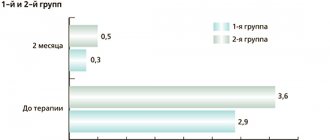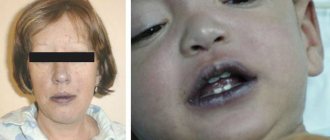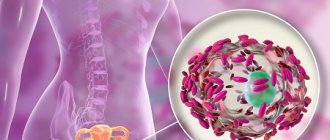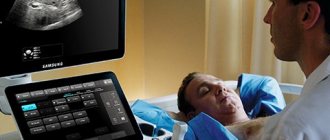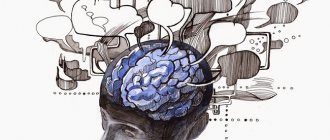Neuroleptics are medications that restore dopamine imbalance in the mesocortical, mesolimbic, nigrostriatal and tuberoinfundibular pathways of the brain, which causes psychotic states. For this reason, drugs in this group are also called antipsychotics. Neuroleptics act on the dopaminergic system in such a way that they eliminate psychotic symptoms - primarily, perceptual deceptions (auditory, visual, tactile hallucinations), delusions and psychomotor agitation.
Treatment with antipsychotics is prescribed for psychotic conditions arising from diseases, for example: schizophrenia, schizoaffective disorder, bipolar affective disorder, mania of various etiologies, depression, brain damage (for example, TBI, stroke), neurological diseases (for example, epilepsy, Parkinson's disease) , dementia. Treatment with antipsychotics is usually long-term. Depending on the disease, the course of taking antipsychotics can last from 3 years; in the presence of a chronic disease, they are taken for life.
Generations of antipsychotics
The leading classification of antipsychotics is based on their chemical structure and therapeutic mechanism of action. It includes three generations of antipsychotic drugs:
- first generation antipsychotics (typical antipsychotics);
- second generation antipsychotics (atypical antipsychotics);
- third generation neuroleptics (new generation neuroleptics).
Typical antipsychotics are derivatives of chemical compounds - thioxanthene, phenothiazine, buterophenone; atypical neuroleptics - derivatives of 1,4-dibenzodiazepine, substituted benzamide and other chemical structure; New generation neuroleptics are partial agonists of dopamine receptors. First-generation antipsychotics quickly and effectively relieve psychotic conditions, but have pronounced non-core actions, unlike second- and third-generation antipsychotics. New generation neuroleptics have a mechanism of action that is innovative from previous generations.
Rice. 1. Generations of antipsychotics.
First generation antipsychotics (typical)
Typical antipsychotics are usually divided into three types according to the mechanism of action on receptors that causes the antipsychotic effect - weak, moderate and strong. Weak antipsychotics have low affinity for dopamine receptors and high affinity for histamine, muscarinic and α-adrenergic receptors. Strong ones, on the contrary, actively bind to dopamine receptors and have low affinity for muscarinic and α-adrenergic receptors.
First generation neuroleptics have a pronounced antipsychotic effect. However, they may not be suitable for all patients due to lack of response to treatment (in about 3 out of 10 patients with schizophrenia, positive symptoms are not relieved) or due to the occurrence of side effects - disturbances of consciousness, dystonia, limb tremors, tardive dyskinesia.
Second generation antipsychotics (atypical)
As a rule, when prescribing treatment with antipsychotics, preference is given to second-generation drugs. Atypical antipsychotics block dopamine receptors selectively, thereby reducing the risk of developing extrapyramidal disorders. In addition, unlike typical antipsychotics, they have additional therapeutically significant positive effects:
- smooth out negative symptoms;
- reduce the risk of developing mild cognitive impairment;
- less likely to cause extrapyramidal disorders;
- do not contribute to the occurrence of tardive dyskinesia.
Some atypical antipsychotics reduce suicidal tendencies during remission due to, for example, sedation; others help to cope with anxiety and insomnia and, on the contrary, if the patient is lethargic, second-generation antipsychotics are selected that do not cause a strong sedative effect
When prescribing atypical antipsychotics, the assessment of therapeutic effectiveness and side effect profile is carried out over a period of 4–8 weeks. In particular, during this period it is necessary to monitor weight and body mass index, fasting blood glucose levels, and blood pressure. The patient should be notified by the attending physician about the first signs of diabetes mellitus, adhere to the principles of a balanced diet and engage in physical activity.
Third (new) generation neuroleptics
Third generation antipsychotics have a different mechanism of action from typical and atypical antipsychotics. The mechanism of the first generation of drugs is to block receptors, which, of course, helps to effectively stop acute and long-term psychotic conditions and provide maintenance treatment. However, residual symptoms, an individual profile of side effects and some difficulties in selecting a drug suitable for a particular patient do not allow them to become the standard for the treatment of psychosis.
The principle of action of new generation neuroleptics is partial agonism to D2- and D3-dopamine receptors, which are a weaker synthetic analogue of dopamine. Taking such drugs allows patients to reduce negative symptoms, cognitive impairment, neurological, metabolic, endocrine and other disorders, and more effectively restore the ability to live independently. In other words, the latest generation of antipsychotics have an expanded range of therapeutic efficacy and an improved safety and tolerability profile.
The principle of partial agonism of new generation antipsychotics is an innovative mechanism that has made it possible to bring the treatment of schizophrenia to a new level by achieving the following effects:
- the effectiveness of relieving positive symptoms is comparable to first and second generation antipsychotics;
- effectiveness is achieved by influencing the receptors of “weakened” dopamine, and not by blocking the receptors;
- therapeutic effectiveness against negative symptoms is determined by mild decompensation of neurotransmission in the dopaminergic system (an effect not available for first- and second-generation antipsychotics);
- the risk of extrapyramidal symptoms (EPS) is minimal or usually absent;
- have significantly improved tolerability.
Third generation antipsychotics are represented by several drugs. The first of them began to be used in 2002 (Aripiprazole), the subsequent ones - in 2015 (for example, Brexpiprazole, Cariprazine). Naturally, the list of newer antipsychotics will expand, but you need to know that the Food and Drug Administration (FDA) designates their mechanism of action as “unknown.”
Basics of treatment for schizophrenia
Treatment of schizophrenia is a long, often lifelong, process.
All antipsychotic drugs have a large number of side effects, so they are prescription drugs. Antipsychotic drugs are prescribed by a psychiatrist, taking into account the manifestations of the disease, the patient’s age, and the presence of other diseases.
Initially, the patient is prescribed typical antipsychotic drugs - they have a powerful antipsychotic effect, but also a large number of side effects. Next, the patient is transferred to atypical antipsychotics - drugs with a moderate antipsychotic effect, but safer in terms of side effects. An additional benefit of atypical antipsychotics is their beneficial effects on memory and mental processes, as well as mood in patients with schizophrenia.
Mechanism of action of antipsychotics
The therapeutic mechanism of action of antipsychotics is associated with the relief of increased dopamine activity in the mesolimbic pathway, one of the dopaminergic nerve pathways. The mesolimbic pathway connects the substantia nigra and the ventral tegmental area of the brain with the structures of the limbic system. This pathway is responsible for processes in the body associated with neuroendocrine regulation, emotions, memory, the ability to learn and experience pleasure. In addition, this system is partially responsible for controlling the onset of motor responses and their affective variations.
Rice. 2. The mechanism of action of neuroleptics.
Blockade of dopamine receptors
Elevated levels of dopamine in the mesolimbic pathway cause psychotic states and productive symptoms (for example, hallucinations, delusions, active manifestations of anxiety states). Typical antipsychotics, by reducing dopamine activity by blocking more than 65% of D2 receptors, reduce positive psychotic symptoms.
The mechanism of action of first-generation antipsychotics can cause non-core effects - motor restlessness, involuntary muscle contractions, contributes to the development of a depressive or anxious state, emotional depression, and anhedonia. Such effects, as they appear, can be stopped by adjusting the dosage or introducing symptomatic therapy.
Long-term blockade of D2 receptors in the mesolimbic structures leads to an increase in the sensitivity of the receptors or an increase in their number, and attempts by neurons to restore intersynaptic connections. This results in hypersensitivity to dopamine and the potential danger of developing psychosis even with a slight increase in the level of the neurotransmitter. “Hypersensitivity” psychosis (positive symptoms) can be triggered by alcohol consumption, smoking and other dopamine-increasing substances, including medications.
Partial blockade of dopamine receptors
Some atypical antipsychotics, which block 2D dopamine receptors partially, mimic the neurotransmitter in its “attenuated form.” Thus, the mechanism of action of second-generation antipsychotics is associated with a “mild” correction of dopamine levels, which contributes to a moderate reduction of positive symptoms and reduces the risks of non-core effects.
Treatment with second-generation antipsychotics reduces the risk of anhedonia, hyperprolactinemia, hypersensitivity psychosis, tardive dyskinesia and extrapyramidal disorders. However, the drugs are still not without side effects, in particular, when they are taken, norepinephrine activity in the substantia nigra remains, which can cause the development of akathisia (internal restlessness, desire for physical activity) with long-term use.
Blockade of serotonin 5-HT2A-, 5-HT1A-, 5-HT2C receptors
The mechanism of action of another group of atypical antipsychotics is associated with the ability to bind to serotonin 5-HT2A receptors, indirectly affecting dopamine levels. 5-HT2A receptors connect the serotonin and dopamine systems, and their blocking leads to a decrease in the activity of the dopamine neuron directly and indirectly by reducing the release of GABA.
When serotonin levels increase, 5-HT1A receptors, which are responsible for the self-regulation of the serotonin neuron, inhibit their activity. This stops the effect of serotonin on 5-HT2A receptors and reduces the activity of the dopamine neuron. A similar, but “mild” effect can be achieved using an agonist that imitates the effect of serotonin on 5-HT1A receptors.
Some second-generation antipsychotics block serotonin 5-HT2C receptors, increasing dopamine levels and decreasing serotonin. The resulting processes in intermediate GABA neurons reduce the production of dopamine. Drugs that act on α2-adrenergic receptors (analogs of 5-HT1A receptors) work on the same principle. Their blockade with an antipsychotic leads to the release of norepinephrine, inhibiting its reuptake and, accordingly, increasing its activity.
These processes explain the therapeutic effect of second-generation antipsychotics, aimed not only at relieving psychotic symptoms, but also at improving cognitive functions, reducing negative symptoms and depressive states. In other words, second-generation drugs are able to correct the levels of dopamine, norepinephrine and serotonin in the brain (mainly in the prefrontal cortex).
Multireceptor blockade
Third-generation neuroleptics have the property of multireceptor blockade, affecting dopamine, serotonin, cholinergic, adrenergic and other systems associated with the occurrence of psychotic states. They have an expanded profile of therapeutic effect, stopping positive symptoms and reducing negative ones; non-core effects occur extremely rarely in clinical practice.
Side effects of antipsychotics
When treated with antipsychotics, neuroleptic syndrome may occur. Extrapyramidal disorders of the syndrome are expressed in hypo- or hyperkinetic disorders. The former are characterized by a decrease in motor activity, stiffness of the muscular skeleton, tremors of the limbs, problems with maintaining balance; the second - tremors, involuntary movements, muscle twitching, spasms of the masticatory muscles, stiffness of movements, slow speech, motor activity. Typically, the neuroleptic syndrome includes both hypo- and hyperkinetic disorders.
Rice. 3. Side effects of neuroleptics.
In neuroleptic syndrome, muscle spasms are paroxysmal in nature. They usually affect the facial and neck muscles - the muscles of the lips, tongue, jaws, eyes, pharynx, and throat contract. In some cases, autonomic disorders appear, even to the point of fainting.
Restlessness, physical activity
In addition to extrapyramidal disorders, akathisia may occur while taking antipsychotics:
- anxiety, restlessness;
- excited state;
- emotional indifference;
- sleep disorders, insomnia;
- feeling of restlessness;
- "restlessness in the legs";
- need to move.
Tardive dyskinesia
If treatment with antipsychotics is carried out long enough (from 2 years), there is a risk of developing tardive dyskinesia. It is expressed in involuntary movements of the lips, tongue, facial expressions, and limbs that are beyond control.
Autonomic nervous system disorders
Disorders of the autonomic nervous system can manifest themselves in postural hypotension (a drop in blood pressure when taking an upright position), dysuric disorders (painful, difficult urination), gastrointestinal disorders (diarrhea, constipation), increased sweating, weight gain, blurred vision, disorders functioning of the cardiovascular system.
Women may develop dysmenorrhea (with an increase in prolactin in the blood), cycle disruption, and manifestations of pseudohermaphroditism; in men - gynecomastia, decreased libido, delayed ejaculation, galactorrhea (secretion of milk from the mammary glands), hirsutism (excessive hair growth). In rare cases, increased sensitivity of the skin to sunlight and ultraviolet rays, dermatitis, pigmentation and allergic reactions occurs.
Severe complications of neuroleptic therapy
In cases where the patient is not observed by the attending physician (does not make follow-up visits, does not notify the doctor about changes in health status that cause anxiety and concern, does not follow recommendations for control and diagnostic measures), there is a risk of developing severe complications of antipsychotic therapy, for example:
- allergic reactions;
- toxic reactions;
- hepatitis;
- pathologies of the organ of vision;
- disorders of blood biochemistry.
In addition, when treated with antipsychotics, there is a risk of developing mental disorders (for example, asthenic type depression), severe sleep disorders, delirium (patients with organic pathology of the central nervous system, the elderly, children fall into the risk category), epileptiform seizures.
Antipsychotics of any generation should be taken in accordance with the recommendations of the attending physician. Refusal to take or increase the dosage unilaterally is unacceptable. Monitoring visits are mandatory, including unplanned ones, if there are signs of deterioration in health. Diagnostic recommendations, including a biochemical blood test, make it possible to assess the effectiveness of therapy and prevent the development of complications.
List of antipsychotic drugs
Depending on the case (intensity of manifestation of one or another psychotic symptomatology; characteristics of the course of the disease), health status, contraindications and other factors important from the point of view of therapy, antipsychotic drugs are selected. Their dosages are adjusted during the treatment process, the drug is often changed, and symptomatic therapy is prescribed.
First generation neuroleptics
Among the typical antipsychotics used to quickly relieve acute conditions, the most well-known are:
- haloperidol;
- fluphenazine;
- flupenthixol;
- Chlopromazine;
- chlorprothixene;
- levomepromazine;
- melperon;
- perphenazine;
- zuclopenthixol;
- sulpiride
Second generation neuroleptics
Atypical antipsychotics, due to their improved action profile, are used as primary therapy for diseases with psychotic symptoms. In clinical practice, the following antipsychotics are most widely used:
- amisulpride;
- aripiprazole;
- clozapine;
- olanzapine;
- quetiapine;
- risperidone;
- sertinadole;
- ziprasidone.
Third generation neuroleptics
The most famous new antipsychotics with an innovative mechanism of action include:
- aripiprazole (first, used since 2002);
- brexpiprazole (a "modification" of aripiprazole) and cariprazine - have been used since 2015.
Classification of antipsychotics
There are several classifications of antipsychotics - according to their chemical structure, as well as according to the characteristics of their action.
Based on their ability to cause drug-induced parkinsonism (a syndrome associated with a lack of dopamine, which is manifested by stiffness of movements, increased muscle tone, trembling of the hands and head, and postural disturbances), antipsychotic drugs are divided into “typical” (which cause it) and “atypical” (which do not cause drug-induced parkinsonism). parkinsonism):
Typical antipsychotics:
- phenothiazine derivatives: aliphatic derivatives (chlorpromazine, levomepromazine);
- piperazine derivatives (perphenazine, trifluoperazine, fluphenazine);
- piperidine derivatives (thioridazine, pipothiazine);
Atypical antipsychotics:
- derivatives of dibenzodiazepine, oxazepine, thiazepine and oxepine: clozapine, olanzapine, loxapine, quetiapine;
- benzisoxazole derivatives: risperidone;
- benzamide derivatives: amisulpride, sulpiride, tiapride;
- indole derivatives: sertindole, ziprasidone;
- others: risperidone, aripiprazole, paliperidone, cariprazine.
In addition, the antihypertensive drug raunatin, which contains reserpine, has an antipsychotic effect.
List of used literature
1. Jones P.B., Buckley P.F. "Schizophrenia. Clinical guidelines".
2. Smulevich A.B. "Treatment of low-grade schizophrenia."
3. Snedkov E.V. "Atypical antipsychotics: searching for solutions to old and new problems."
4. Krasnov V.N., Gurovich I.Ya., Mosolov S.N., Shmukler A.B. "Standards of care for patients with schizophrenia."
5. Ivanov S.V., Smulevich A.B., Voronova E.I. “New generation antipsychotic cariprazine in the treatment of schizophrenia: spectrum of clinical efficacy and safety.”
6. Geddes J., Freemantle N., Harrison P., Bebbington P. “Atypical antipsychotics in the treatment of schizophrenia: systematic overview and meta-regression analysis.”
7. Jindal RD, Keshavan MS “Classifying antipsychotic agents. Need for new terminology."
8. Correll CU, Rubio JM, Inczedy-Farkas G. “Efficacy of 42 pharmacologic cotreatment strategies added to antipsychotic monotherapy in schizophrenia.”
9. Wang S.M., Han C., Lee S.J. “Investigational dopamine antagonists for the treatment of schizophrenia.”
10. K.S. Raevsky. "Modern neuroleptics: interaction with brain neurotransmitter systems."
Share
Share
Features of treatment of schizophrenia
According to modern requirements, treatment of schizophrenia includes three subsequent stages:
- Relieving or active therapy – aimed at quickly eliminating delusions and hallucinations. Duration – 4-12 weeks. Typical antipsychotic drugs are usually used.
- Aftercare, stabilizing or maintenance therapy – stabilization of the patient’s condition, elimination of depressed mood, normalization of interest in life, memory and mental processes. Duration – 3-9 months. Atypical antipsychotics are usually used.
- Anti-relapse or preventive therapy – preventing the development of new attacks and slowing down the rate of deterioration of the disease. Duration is indefinite, but not less than 1-2 years. Atypical antipsychotics are usually used.
With prolonged use of antipsychotic drugs, addiction develops to them (decreased effect), and depression may develop.
Cost of treatment in our clinic
| Service | Price | |
| Ambulatory treatment | ||
| Psychiatrist consultation | 4 500 ₽ | |
| Consultation with a psychotherapist | 4 500 ₽ | |
| Psychodiagnostics extended | 7 000 ₽ | |
| Consultation with a psychiatrist at home | 6 000 ₽ | |
| Treatment in hospital | ||
| Delivery to hospital | For free | |
| Standard room | 7 700 ₽ | |
| 3-bed superior room | 10 600 ₽ | |
| 2-bed superior room | 13 700 ₽ | |
| 1 local VIP chamber | 19 000 ₽ | |
| Doctor's appointment 2 weeks after discharge | For free | |

